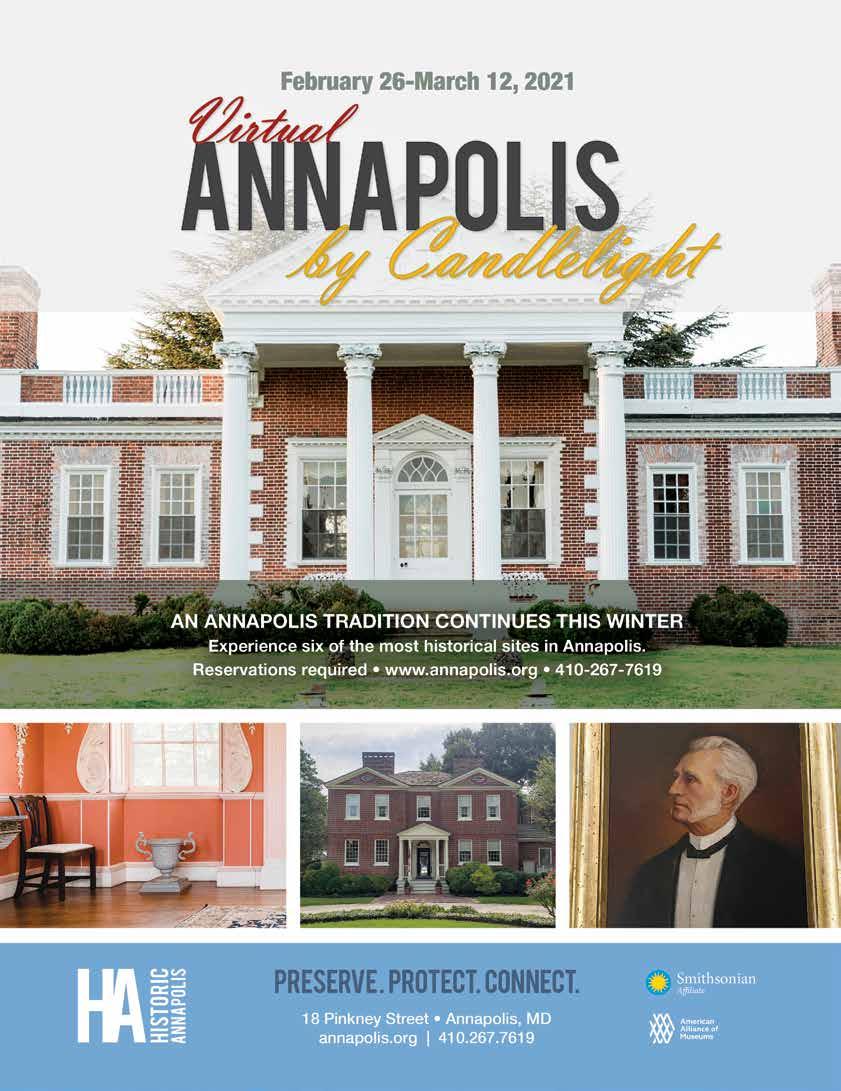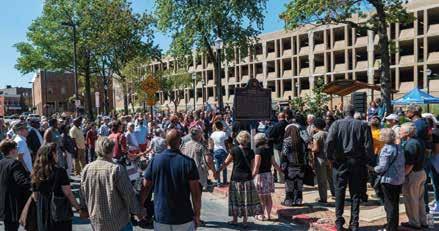
17 minute read
One Nation: A Diversity
A Future with Liberty and Justice for All
Editor’s note: Readers, our publication is embarking on an ambitious, if overdue, series of articles this year (six are planned) that will explore, address, and attempt to convey with empathy and direct perspective issues of race and culture within our communities. These issues are not limited to racial inequalities or suffering. We intend to also share stories of success and hope…a hope that all Americans may be afforded equal recognition, dignity, and opportunity because it is the fabric of culture, many cultures, that make our communities and country the very best in which to live. And by sharing these stories, we may learn from one another. The first article in this series is… Efforts are underway nationwide and in Maryland to educate our communities about the debilitating and devastating effects of systemic racism; and how to heal // By Ines Pinto Alicea
Systemic racism, the legacy of slavery in the U.S., embedded itself within many of the country’s institutions, and continues to have a crippling economic impact on Black families in the Chesapeake region today.
“(Systemic racism) is a system that continually advantages one group and systematically disadvantages another over time,” says author Melvin Oliver, who also serves as president of Pitzer College in Southern California.
Systemic racism has created sharply disparate outcomes for Blacks in the job market, economic wealth, housing, education, justice system, and health care. Federal data show that Blacks comprise 13 percent of the U.S. population yet own only 2.7 percent of the nation’s wealth and are more than 40 percent of the nation’s incarcerated. Ibrahim X. Kendi argues in his book Stamped from the Beginning: The Definitive History of Racist Ideas in America, that racism, greed, and the governmental policies that supported that path are at fault.
In his book Invisible Americans: The Tragic Cost of Child Poverty, former New York Times economic columnist Jeff Madrick debunked many myths about poverty and Blacks that have persisted for decades. Madrick found that 16.9 million Whites are poor, roughly double the number of poor Blacks, and Whites receive the 69 percent of government benefits designated for the poor, discrediting mistaken beliefs that Blacks make up the nation’s poor and receive the bulk of government benefit. “The beneficiaries of slavery, segregation, and mass incarceration have produced racist ideas of Black people being suited for or deserving of the confines of slavery, segregation, or jail,” Kendi adds.
Still, poverty is a challenge for the Black community, one that is compounded by a history of deliberate and intentional racist federal and state laws and policies.
In Annapolis, with a population of 39,147 residents, 23 percent, or 1,976, of 8,593 Black Annapolitans live in poverty and in Easton, Maryland, Blacks comprise 13 percent of the population of 16,551. Yet, 25 percent live below poverty, according to U.S. Census data. Poverty is defined as earning less than $12,140 for an individual.
Poverty is devastating, but for children and the country, the long-term economic impact can be “stunning,” resulting in $1 trillion in lost national income—GDP—due to “reduced labor productivity of workers, higher health costs, and the costs of crime, including incarceration,” writes Madrick.
“These children….live not merely in deprivation, but also in shame,” Madrick suggests. “They see themselves as irredeemable outsiders. When Americans scoff at poor kids because their parents buy them the latest expensive sneakers and iPhones, they are unaware these kids demand these things not to show off, but mostly to belong, a deep need of which they are mostly deprived.”
Several efforts are under way across the country, including in Maryland, to acknowledge, address, and atone for some of the damage and pain caused by slavery and racism.
Historic marker dedication ceremony in September 2019 at People’s Park (formerly Whitmore Park) in Annapolis, acknowledged the racial terror lynching of African Americans in the U.S. and, specifically, Anne Arundel County. Photo by Christian Smooth for Equal Justice Initiative.
But First, A History
Between 1619 and 1697, 100,000 Africans arrived as slaves in Maryland and by 1755, half of the state’s population were African, says the Guide to the History of Slavery in Maryland. Maryland did not abolish slavery until 200 years later in 1864.
Laws, policies, broken promises, and other manmade forces stymied the efforts of freed Blacks to be self-sufficient and economically stable, denying them wealth-building opportunities. For example, the nation’s capital paid former owners of slaves, not the enslaved, up to $300 for each slave freed under the District of Columbia Compensated Emancipation Act of 1862.
“Slaves never saw that money,” says Elinor Thompson, a historian, author, genealogist, and Annapolitan who serves on the Maryland Commission on African American History and Culture. “Even when the slaves were sent to fight in the Civil War, the slave owners got $300 and more for having lost a worker. Many of the slaves who fought in the war were never given the pensions they were promised.”
President Abraham Lincoln ordered 40 acres of land be given to each freed slave so they could be self-sufficient and start their new lives with economic stability, but the order was never fulfilled, writes Willam A. Darity, Jr., and A. Kirsten Mullen in their book From Here to Equality: Reparations for Black Americans in the Twenty-First Century. Even when Blacks purchased land, the land was often confiscated from them.
Later, freed Blacks labored as sharecroppers at White-owned farms for a portion of the crop. The system was fraught with wage theft and state-sanctioned discrimination. That dynamic is the core of the 10-to-1 wealth disparity between Whites and Blacks that has persisted for decades, writes Oliver, co-author of Black Wealth/White Wealth: A New Perspective on Racial Inequality. The 2019 Federal Reserve Survey of Consumer Finances shows that 45 percent of Black families own their homes compared to 73.7 percent homeownership rate for White families. The median home value for Black families was $150,000 while it was $230,000 for White families. The gap in home ownership and in the values of homes has made it difficult for Blacks to build generational wealth.
Redlining—the practice of banks either denying mortgages to people in minority neighborhoods or charging those borrowers more—limited Black home buyers’ options through much of the 20th Century. In his book, The Color of Law: The Forgotten History of How Our Government Segregated America, Richard Rothstein wrote that starting in the 1930s, the Federal Housing Administration discriminated against Blacks wanting to buy homes by drawing maps that clearly indicated that the federal government would back mortgages in White communities, but deemed homes in Black communities as too risky to back, forcing Black homeowners, no matter how creditworthy they were, to accept higher interest loans and more severe terms. Even today, “homes in Black neighborhoods that are similar to a house in a White subdivision with a similar economic makeup would be undervalued by as much as 65 percent,” wrote Michelle Singletary in a recent Washington Post article.
After World War II, the Veterans Administration denied Black veterans the lower-cost government guaranteed mortgages that White veterans used to help build wealth for their descendants.
Attempts to integrate housing continue to be blocked at the highest levels of government. In July 2020, the Trump Administration eliminated a housing regulation designed to reduce racial disparities in neighborhoods, claiming, without evidence, that such desegregation would lead to more crime.
Other federal policies have an impact as well. Low interest rates, for example, can reduce unemployment and often boost the stock market, but those benefits disproportionately accrue to White Americans who are more likely to hold investments.
Our Towns Today
In Annapolis, the median income for Whites is $104,301 while it is $43,443 for Blacks. In Easton, there is a $23,000 gap in median income between Whites and Blacks, the Census said. The Federal Reserve’s 2019 Survey of Consumer Finances showed White families had larger accounts with emergency funds, were more than three times as likely as Black families to receive an inheritance, and owned more stocks than Black families.

dress economic inequality. Some are more symbolic, but meaningful in the healing process.
Talbot County recently created a diversity statement that all employees and volunteers must adhere to in planning work and events. The county also requires an annual diversity report, listing where diversity training is occurring and how much is spent.
“Now, comes the more difficult part of creating more diverse management in the county,” says Talbot County Council President Corey Pack.
Pack, who has served on the council for 13 years, says the largely peaceful social justice demonstrations this past year were the biggest the county has seen. Pack found the demonstrations a “refreshing” exercise of First Amendment rights, but he was troubled by the “lack of openness among some of my colleagues” and some of the comments labeling the demonstrations as “Anti-American.”
“I’m hoping the leadership in Talbot County can have conversations that are open, frank, and sometimes difficult,” Pack says. “I wish I could tell you we’ve taken great strides. We’re still trying to make connections and have difficult conversations.”
Anne Arundel symbolically changed its motto from “The Best Place” to “The Best Place for All,” but Anne Arundel County Executive Steuart Pittman also declared racism a public health issue and formed an Office of Health Equity and Racial justice. He told the Washington Post in September, “We are America…a country built on a system of racial terror…we say ‘liberty and justice for all,’ (but) we know we’re not there.”
Other symbolic gestures abound. Annapolis commissioned two murals, one of the late U.S. Rep. and civil rights icon John Lewis in downtown and one in Parole of Breonna Taylor, the 26-year-old who Louisville police shot to death in her home and were later cleared of her death.
“We’re saying we need to do better,” says William F. Rowel, senior advisor to Annapolis Mayor Gavin Buckley and director of the city’s office of Public Engagement and Community Relations. “We’re not saying ‘you are a racist and we are going to tear your buildings down.’ We’re into restorative justice.”
In 2019, the United Nations Educational, Scientific and Cultural Organization (UNESCO) designated Annapolis, more specifically the City Dock, as a World Heritage Site for being one of 52 locations nationwide where some 30,000 children, women, and men in bondage first placed their feet after leaving Africa.
“Four signers of the Declaration of Independence lived in Annapolis and all owned slaves,” Rowel says. “Their wealth came from human cargo.”
Rowel says a 2018 study on how to renovate the Annapolis dock calls on the city to be more inclusive of the African American community. The report recommended Annapolis initiate two steps: “a community dialogue…on commemoration and interpretation…regarding the history of race on this site” and “an inclusive cultural landscape interpretation process to reverse the social and economic exclusive narratives that exist.”
Annapolis felt the tug for inclusion when it recently renamed Whitmore Park in response to last year’s demonstrations. Some in the African American community felt slighted because it was named The People’s Park, not truly reflective of the site to which it was dedicated, the old fourth ward, a vibrant area of Black-owned businesses and homes. A federal policy of urban renewal during the 1950s and 1960s led to land acquisition and seizures through eminent domain along Washington, Calvert, and Clay streets to build the Whitmore Garage. Black Annapolitans use the term “urban removal” to describe what happened to their neighborhoods.
“That disenfranchisement of the Black community created a loss of wealth and in exchange, people fell into a system of generation after generation living in public housing,” says Adetola O. Ajayi, African American Community Services Specialist for Mayor Buckley. “It is very difficult to transition from The painting of the Breonna Taylor & Black Lives Matter mural project took place in Summer 2020 in the aftermath of national protest due to the fatal shooting of Breonna Taylor by law enforcement in Kentucky. Local artists collaborated with Future History Now, Banneker-Douglass Museum, and Maryland Commission on African American History and Culture to create the 7,000 square foot mural at Chambers Park in Annapolis. In August, Tamika Palmer (Breonna Taylor’s mother) and family visited her mural and were joined by Annapolis Mayor Gavin Buckley, The Maryland Commission on African American History and Culture, activists and artists, BDM Executive Director Chanel Compton, and the Parole community. Photos courtesy Banneker-Douglass Museum.
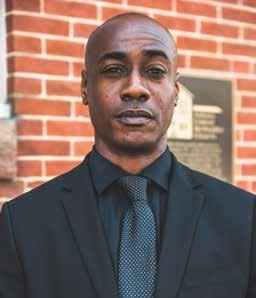
public housing to a $400,000 home. You have to be earning at least $70,000 to do that and if African Americans are earning less than that…”
And “someone working full-time at minimum wage makes only 40 percent of the income needed to afford a two-bedroom apartment in Maryland” states Marylanders Against Poverty, an organization comprised of social justice and religious organizations.
Ajayi says his office has focused outreach efforts to the African American community on worker training and activities for young people.
Janice Hayes-Williams, a historian and director of the Anne Arundel County Office of Community Engagement and Constituent Services, has led several symbolic restorative justice efforts. Every year, she hosts a ceremony remembering Blacks who died at the former mental institution, Crownsville Hospital Center. She said 1,700 Black people buried there had not been identified and she plans to identify every individual.
She also led an effort to identify Blacks buried in a cemetery destroyed during the redevelopment of downtown. She said the bones were dug up and put in boxes with no identity. This past Fall, after identifying that some bones were of Smith Price, who in 1803 founded Asbury United Methodist Church, one of the oldest African American churches in Annapolis, she arranged a burial ceremony at St. Anne’s Cemetery. Ajayi says Price’s burial helped raise awareness about the contributions of a prominent Black community member and “did some restorative healing.”
Forward Thinking & Action
Ajayi says few buildings in Annapolis convey the history of Blacks in Annapolis and efforts are underway to highlight more contributions of the African American community.
Annapolis acquired the Maynard-Burgess House, which was originally bought by John Maynard, who was born a free Black man in 1811. The city is renovating it to depict 19th century African American life in Annapolis. The city also secured a $200,000 grant to renovate Universal No. 14 Masonic Lodge, the meeting site of one of the state’s oldest African American Masonic chapters. Located at 64 Clay Street, the building, which dates to 1880, is on the National Register of Historic Places. Masons share a guiding moral code centered on commitment to brotherhood and community.
“Everyone has a role in bringing about change. It can’t be all on schools or the faith community…,” says Anthony Spencer, an Annapolitan artist who also serves on the Maryland Commission on African American History and Culture. He adds that he hopes for the renaming of Taney Street, named after U.S. Supreme Court Justice Roger B. Taney who ruled in the Dred Scott case that the U.S. Constitution was not meant to include American citizenship for Blacks.
“The request (for a name change) should come from the neighbors on that street,” Spencer says.
Other efforts more directly combat problems the Black community has voiced about social inequality. In October, a major law took effect broadening the definition of what comprises a hate crime and helping prosecutors hold individuals accountable for hate crimes in Maryland.
Several governments, including D.C. and California, are exploring reparations to the descendants of slaves. The U.S. Conference of Mayors is among the organizations that supported federal legislation to study the feasibility of reparations on a nationwide scale, endorsing the movement at its July conference.
Reparations are not new. In 1988, President Ronald Reagan offered a formal apology and paid $20,000 to 100,000 Japanese Americans who were detained in internment camps in 1942 after Japan attacked Pearl Harbor.
“At some point, Annapolis is going to have to pay their reparations,” Hayes Williams says. “I would like to see it take the form of education and closing any achievement gaps.”
Ajayi says the city faces many financial constraints to bring about major change for the African American community because many of the major buildings within its confines, like the U.S. Naval Academy, the Governor’s mansion, and the State House do not pay taxes, contributing little to the city’s tax base though they provide substantial employment for Annapolitans.
One of the bigger efforts to address past injustices against the Black community was created by a unanimous vote of the Maryland Legislature. The Maryland Lynching Truth and Reconciliation Commission is spending the next three years researching, filing subpoenas for testimony, and collecting histories of the people who were lynched in Maryland and whose perpetrators were never held accountable.
“(The work) of the lynching commission will help tremendously because it is unraveling the lies and starting to tell the truth,” Spencer says.
David Fakunle, the commission chair, says many Americans witnessed their first lynching last year after George Floyd, a Black man in Minneapolis, spent nearly nine minutes suffocating to death under a police officer’s knee. Floyd’s death was a catalyst for global protests against social inequity. Fakunle says the Trump Administration and the Covid pandemic “revealed a lot of hypocrisies and ugliness of this country,” making the time ripe for the work of the commission.
“The country is overdue its reckoning,” Fakunle says. “We’re not going to go light on this. Someone has to be the first to start this conversation. We want the commission to be the first, to be a model, and to set a precedent.”
Maryland is one of eight states where lynching was common according to the Equal Justice Initiative (EJI), a nonprofit legal and civil rights group that documented thousands of lynchings. Last year, the organization sponsored a historical marker memorializing the lynchings in Anne Arundel County, the site of five of 42 lynchings in Maryland between 1854 and 1933.
“Their deaths were not in vain,” says Fakunle, adding the commission hopes to also offer strategies to begin healing. “We will all do our best to bring justice. We are serious about the work we are doing and trying to be transparent and bring as many people in as possible.”
The Maryland Legislature’s bill that created the commission notes “State, county, and local government entities colluded in the commission of crimes and conspired to conceal the identities of the parties involved;” that the crimes “intended to terrorize African American communities and force them into silence and subservience to the ideology of white supremacy;” and that “no victim’s family or community ever received a formal apology or compensation from the State, county, or local government entities for the violent loss of their men.”
Filmmaker Will Schwarz produced a YouTube documentary called Outrage in Rockland: The Lynching of Howard Cooper about how a masked mob in 1885 dragged Cooper out of the jail where he was being held and hung him from a tree in front of the jail. Even before the trial, the Baltimore Sun called the accusations against Cooper, who was falsely accused of rape, the “most shocking crime ever” and placed his age at 24. It was not until Schwarz and others organized a memorial recently for Cooper that a local historian discovered he was only 15.
“If we are going for any meaningful reconciliation and any meaningful progress in race relations, we have to understand and know that history,” says Nicholas Creary, a professor at the University of Iowa who was instrumental in the creation of the Maryland lynching commission and serves as a commissioner. “It is too important not to know.”
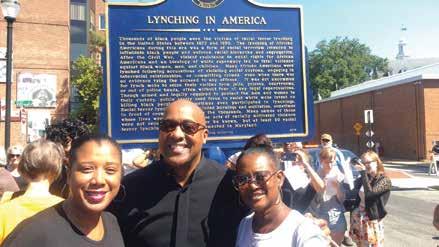
Additional credit to Annapolitan Melissa Pantalone for historical background and research. Top: Maryland Lynching Truth and Reconciliation commissioner Maya Davis with Maryland Commission on African American History and Culture commissioners Anthony Spencer and Elinor Thompson at the historic marker dedication.
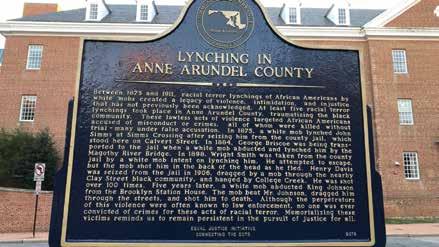
Bottom: The reverse side of the historical marker acknowledges the lynching of John Simms, George Briscoe, Wright Smith, Henry Davis, and King Johnson that took place in Anne Arundel County.
